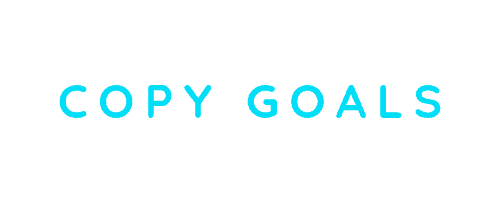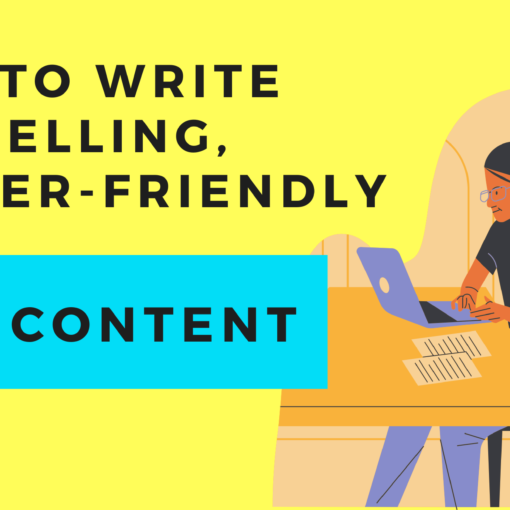B2B content has to be top quality.
The reason being, 62% of B2B buyers say they can make a business decision based purely on online content.
Which shows the persuasive influence of content and its impact on conversions.
But how do you write B2B blog posts that meet industry standards and audience expectations?
Think about your go-to blogs…
Maybe you dig HubSpot, Neil Patel, Sales Hacker or similar sites.
Whatever your favorite industry blogs are, you’ll no doubt notice similar styles of content and recurring elements.
That’s because there is a quintessential model for B2B content.
This checklist will help you master the fundamental elements of B2B writing once and for all.
CONTENTS
Headline

- Compelling
Out of everybody that reads your headline, only 20% will click through to read your content.
People are bombarded with information all day, every day.
Which means they are used to zoning out headlines that don’t grab their attention straight away.
Here’s an example of a compelling headline versus a basic headline:
Create enticing headlines that make searchers want to click.
- Non-Spammy
Avoid clickbait headlines at all costs.
Like a spam sandwich, they leave a bad taste in the mouth of the reader.
Take a look at the following headline:
The brand claims to have “A Complete List”.
But when you click through there are only 20 or so items…
Other search results have 90+ items, so can this post really be a complete list?
If you’re going to make bold claims, you have to follow through.
Or readers will simply bounce.
Which is bad for SEO, of course, and makes your brand seem untrustworthy.
- Data-Driven
Real numbers make B2B headlines compelling and authoritative.
Studies show that research-backed, data-driven posts get more traffic.
So, include data in your headlines where relevant.
Here are a couple of nice examples:
- Headline Formulas
BuzzSumo recently discovered which headline phrases work best for B2B content:
“The Future of” is the clear winner here.
Take a formulaic approach by applying these phrases to your topics e.g. “The Future of App Development”.
There are tons of other proven formulas you can apply, too:
This approach will save you time and energy when crafting clickworthy headlines.
Layout

- Short Paragraphs
The most important aspect of your layout is readability.
As Steve Linney at Content Marketing Institute explains, “Poor readability is a signal that you’re not looking after your audience.”
To keep readers engaged use short paragraphs, short sentences and short words.
Neil Patel keeps your eyes moving down the page by using short paragraphs:
- Word Count
Your paragraphs might be short but, as a B2B brand, you need long-form content.
There have been a million and one studies about content length.
And honestly, there isn’t some magic number you need to stick to for every post.
But you should aim for around 2,000 words or more.
Because B2B topics are complex and you can’t create a thorough, high utility blog post in fewer words.
- Defined Sub-Sections
I know it seems like “Blogging 101”…
But you’d be surprised by how many brands still publish an unappealing wall of text and call it a blog post.
You must break up the text into defined sub-sections with headers.
Use H2 and H3 tags – that’s what they’re there for.
And place them in a logical order so your blog posts are easy to follow.
- Bulleted/Numbered Lists
Many readers skim content to find specific information.
So, along with defined sub-sections, mini lists make your posts easier to absorb overall.
As in this example:
Your simple and defined layout should be immediately clear when visitors open your page.
Or they won’t bother reading your content.
Writing

- Alluring Introduction
All articles need a punchy opening that makes you want to continue reading.
For B2B blog posts, there are a few approaches that work particularly well.
Start with a bold statement that gets straight to the point:
Pick a particularly surprising statistic that illustrates your argument:
Or open with an analogy that proves you thoroughly understand your customers:
Btwz, if you’re into writing then you may want to check out my list of the best blogging platforms. Go out there and do your own thang, hunty.
- Copywriting Techniques
Copywriting techniques make your posts all the more convincing.
According to Quicksprout’s Complete Guide to Copywriting,
“If you can leverage your writing to tell a compelling story while convincing customers of the need for your product, there is no limit to the growth your business can experience.”
Many B2B writers use the PAS technique to aid their storytelling.
PAS stands for Problem-Agitate-Solve.
First, present the reader’s problem or pain point.
Express why the problem is so significant to agitate the reader.
And finally, present an actionable solution (or tease the solution if you’re using the technique in your introduction).
Here’s an example of PAS in action:
It’s a simple but effective formula you can use for each of your sub-sections.
- Personality
You or I might find, say, search algorithms fascinating…
But some people find such topics about as interesting as one of Ross Gellar’s lectures.
Establish a brand voice with some personality to make dry topics more engaging, and set your brand apart.
Use humor to liven up your content.
Here Sales Hacker applies hyperbole and even includes a cartoon to have some fun with their topic:
Another option is to express your true opinions or values within content.
And if it fits your brand, you could throw in some slang and pop culture references.
I prefer a conversational tone as it makes complex B2B or tech topics easier to follow.
- Actionable
In each section you need to provide actionable advice that readers can take away.
This adds value to your content, as B2B buyers want a tangible solution to their problems.
90% of the most successful content marketers prioritize their readers’ informational needs over a sales or promotional message.
The best way to provide actionable advice is through detailed walkthroughs or step-by-step guides.
Here, OptinMonster includes precise steps within their content:
- Strong Call to Action
B2B audiences do not respond to big claims about a product or service.
They like to consider their options carefully.
45% of B2B buyers use more sources to research and evaluate purchases compared to last year.
So, your CTA shouldn’t be “My product is great, sign up now!”
But rather, carefully considered as part of a wider B2B content marketing strategy.
And dependent on where the reader is in your content marketing funnel.
For example, this CTA from Outbrain leads to a product demonstration i.e. the next step in the funnel:
Your CTA must be powerful to encourage the user to take action.
Frame your words in a way that solves the reader’s pain point.
Note how Outbrain says “Take your native advertising to the next level”, rather than “Try a demo”.
Evidence

- Data/Statistics
B2B buyers use data to inform their purchase decisions.
75% firmly believe that content producers should back up their claims with more data and research.
Use statistics and data to prove your points and also…
To show progression or change over time:
To establish industry benchmarks:
To show discrepancies or correlations:
Use your own data/studies or gather data from other credible sources.
- Quotes
Quotes from industry leaders or experts also add tons of credibility to your content.
Find relevant quotes from authority sites while researching your content.
And integrate them into your text like so:
Or gather a list of influencers and reach out to them via email or social media.
You’d be surprised by how many are willing to share a quick quote in return for a mention in your post.
- Real-World Examples
Show, don’t tell… it’s a classic writing technique.
In this context, you need to provide real, contemporary examples of what you’re writing about.
This not only drives your point home but also gives readers a model or idea they can adapt to suit their needs.
Here, Sleeknote provides an example to demonstrate their tip in action:
- Case Studies
Case studies make compelling evidence.
Not only do they make your content memorable but they also allow you to weave real pieces of convincing data into your text.
Ed Gandia at American Writers & Artists Inc. says,
“Stories engage us on an emotional level, creating a deeper, intimate bond. And because of that, we remember them — and we tend to remember everything around them. In other words, we may not remember a statistic by itself. But when used in the context of a compelling story, we’ll remember both the story AND the statistic.”
Integrate your own case studies into your writing or find examples from credible non-competitors.
In one of their posts, Campaign Monitor advises companies to share useful content prior to launching a new product.
They then detail a case study in which this method was successful to support their idea:
Images

- Screenshots
In B2B content, images are used for instructive or explanatory purposes.
Screenshots allow you to present the real examples and walkthroughs mentioned above.
Skitch is a brilliant tool you can use to take and annotate screenshots.
See the annotated images in this post.
- Graphs/Graphics
Graphs/graphics stick in readers’ minds, act as supporting evidence for your claims and make it easier to absorb data.
Clearly reference any graphs, charts or graphics you take from outside sources.
In many cases, the source hopes other brands pick up their graphs or graphics so that they can earn links.
Here Single Grain provides an editorially placed backlink to the source, so it’s a win-win:
Alternatively, use a free tool such as Piktochart or Canva to create your own original graphics.
- Other Media
You may also wish to use other forms of media to expand on or explain your ideas.
Video, for instance, has become ubiquitous in B2B content marketing.
In fact, those in high tech and professional service industries produce the most new videos each month.
CoSchedule incorporates a useful and relevant demo video here:
There are other options, too, such as SlideShare or podcasts.
SEO

- SEO Basics
SEO is vital to your B2B blog strategy.
72% of B2B buyers turn to Google in the awareness stage of their journey.
There are certain elements of SEO that you need to check off for every single blog post…
Header tags, metadata, internal/external linking and so on.
Use a plugin such as Yoast to analyze your posts and make sure you have the key SEO points covered each time:
Yoast also offers readability analysis, which is extremely useful.
- E-A-T
E-A-T (Expertise-Authority-Trust) is a major aspect of SEO for 2019 and beyond.
Google introduced a broad core algorithm update in August 2018 (the “medic” update) which was all about E-A-T.
What does this mean for your B2B content?
It reinforces the point that you need to use supporting evidence, such as data and quotes from experts to demonstrate your expertise and authority.
Furthermore, credible authors will boost your E-A-T score.
So, outline the credentials of your writers at the end of each post.
Like this:
It would also be beneficial to boost their profiles elsewhere on the web through guest posts.
- Search Intent
There are four types of search intent:
1. Informational – Looking for information or an answer to a question e.g. “How does automation work?”.
2. Navigational – Looking for a specific website e.g. “Facebook”.
3. Transactional – Looking to make a purchase e.g. “Grammarly Premium Price”.
4. Commercial Investigation – Looking for a product or service but yet to make a decision e.g. “WooCommerce Review”.
Therefore, you need to optimize your content for informational queries or commercial investigation.
Though old school elements, such as keywords, still count.
It’s more important to think about the intent behind search queries.
And ensure you thoroughly answer the searcher’s query or solve their problem.
Final Word
The best examples of B2B blog posts share many similarities…
Which allows us to form a blueprint for effective B2B content writing.
You may not be able to tick every single box every time.
But you should aim for Hermione Granger levels of diligence and tick as many as possible.
Now it’s over to you.
Does your existing content contain these essential elements?
Do you have a framework for new blog posts?
Download the entire checklist and start creating epic B2B content…



